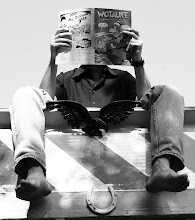
OK.
So.
There’s something I’d love to have cleared up before I exit this human story, something I’d like to have removed from the general concern, from the shared consciousness of man – that mushy grey ball we pass around the grown-up playground – mollified by its indifference, comforted by its inscrutability.
It’s this God character.
I think his last name might be Damn.
Or maybe Dammit!
You know who I mean – old crusty whitebeard – the King of Morality, Kurt Warner’s number one fan, straddling his cumulus pony, eating his orange stars and yellow moons – the invisible lover whispering sweet nothings to George Walker Bush – all the while dragging the stringy entrails of self-worship, self-love and self-abuse – about the face of a planet that really just wants to go fishing on a Sunday morning.
God almighty!
God, the drunken master – Geppetto by way of Unibomber – a fashion nightmare, even more unkempt, more hirsute than his shaggy son – toiling with the cross that bears no marionette – the wooden child having been banished to walk the Earth – to parade mortal with the sheep, the crow, the louse – Jim Carrey eating the placenta of George Burns.
Of course, we all know God is story, mere mythical bunk – and that’s what concerns me here – the power of this dominant fable – and how it has permeated more than just our culture – how it has transformed, transfigured our very cerebral organ, that grey matter composed to offer faith but demand reason – forever sweetening the poison with sugar – giving us a Death wearing Grace Kelly’s face.
The faith-based concept of a living God – the creator – a colossal Visine-washed eye looking down on the Green Giant’s fertile valley – has transformed our very psyche. It’s a pitiful case of the worm turning on the robin – Pinocchio besting the whale – the human mind lost in masturbation, transfixed with its own reflection – belief believing in belief – and the provenance of tiny blue faeries.
The notion of belief, of faith, is entirely irrational, and yet it has served the great majority of mankind – ever since we first bumped our heads on the cave ceiling, replacing common sense with her fiendish brother of progress, common reason – both constantly demanding our hand learn a new dance – from the preachy pitch of Hamburger Helper to the erudite skulk of Thing – the gothic American family fed on the blood of the lamb.
We utilize faith to counter other harsh realities, most of these involving instances where random fate is overwhelmingly indifferent, where belief is all one has to draw upon – John Wayne’s face imploring the camera – the teal-eyed thicket through which we weave the concepts of god and love.
Here, faith is often a powerful force, an emotional impetus that can better the lot of many, but, it is still, nonetheless, an act of insanity – a willful leap off the edge of a tall building – one that, in the end, is no less mad than any other jump of logic – any Superman to suicide leap.
One might as well put all their capacity for belief in the legend of the Tooth Fairy – it would amount to the same thing – a fable of supernatural design, formulated to teach a moral code, usurped by all, contested by none – even the non-believer, trapped behind the mirror – peeling away the black paper to find his own Cheshire grin.
It would be a fable both moderated, and modulated, by the generations – traveling through time as it travels across the land – spreading the continents like a viral flood, greedy arms reaching out, fanning the flames of rapture.
Ultimately, by this fashion, the story supersedes the reality, life itself being redefined as something existing only in its service to the fable – you and I becoming a part of that tale – rather than the other way around – the indecisive camel having become the pushmi-pullyu, our senses but a blur in the light of God and his mercy.
In a classic demonstration of reality-based counter-demagoguery, the believer rebuffs the demand of fact by demanding an absolute, working upon the assumption that existence predates proof – and the leprechaun is not to be judged.
It quickly becomes a crime scene where the lack of evidence is the greatest tool in the detective’s armory – a murder story where everyone did it – where the final act features only a gun made of smoke – and a “Howdy, Pilgrim!”






